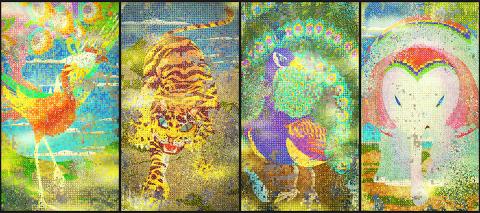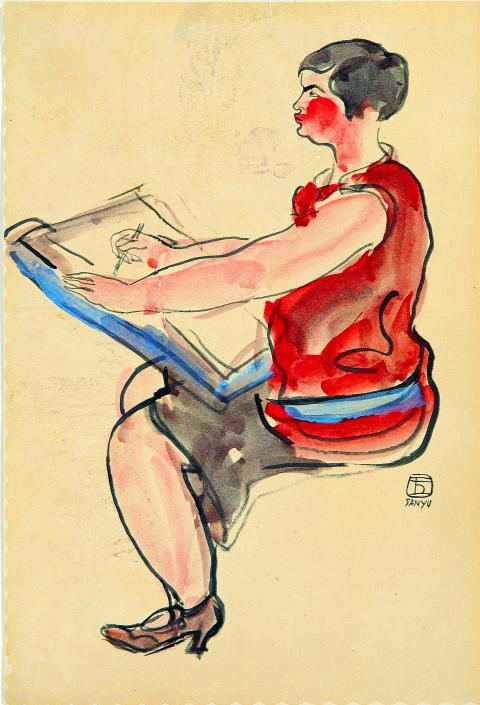Art Taipei (台北藝博會) felt like a minimally designed, intimate dinner party with a moderate market adrenaline. Hosted by Taipei’s World Trade Center (台北世貿中心) from Thursday to Sunday last week, the gray and white event was subtly decorated with occasional LED gateways and modern chandeliers that lent it a touch of noble prestige in the otherwise gridded modules of white-cubed spaces. At the main entrance, Art Taipei’s academically sounding theme The Rise in Private Art Museums was spelled in big letters, promising that this year’s program was set up to be much more than a trade show experience. Along the aisles, familiar dealers and collectors casually chitchatted with each other, catching up on old friendships and art world news.
Considerably smaller in size than previous years, the 24th edition of Art Taipei hosted 123 galleries from 15 Asian countries, including China, Taiwan, Hong Kong, Korea, Japan and Southeast Asia. Organized by Taiwan Art Gallery Association (社團法人中華民國畫廊協會), Taiwan External Trade Development Council (中華民國對外貿易發展協會), and the Ministry of Culture (文化部), Art Taipei is the longest running art fair in Asia and has established itself as a senior platform for artistic and commercial exchange within the Asian region. While Hong Kong has quickly risen as an epicenter for art dealing within the last decade, Art Taipei continues to vie for critical position as a center for international exchange. With the proliferation of art fairs across Asia, the fair this year seemed to show a strategic shift in its approach to maintaining a stake in the regional network.
The fair’s title set up a contemplative mood for discussion about collection building and institutional development. In addition to being a leading force in the art market, according to Minister of Culture Cheng Li-Chun (鄭麗君), Art Taipei “is an exchange platform for culture and thought, and an embodiment of contemporary art trends and the spirit of the times.” By placing emphasis on the cultivation of arts, the fair shows potential for a refreshing blend between art appreciation and business talk.

Photo courtesy of Liang Gallery
With a total offering of 3,000 works this year, Art Taipei reportedly hit NT$5 million in total sales by the second day. Representing works by Yoyoi Kusama and Shiro Tsujimura, Nukaga Gallery achieved a collective sales of almost NT$2 million. Wu Hsueh Jang’s (吳學讓) ink paintings at Mingshan Art (名山畫廊) were 80 percent sold by the first day of the fair. Other pieces that attracted collector’s interest include Tang Jie’s (湯傑) Stone Story (石雨) and Geng Jie-Sheng’s (耿傑生) A Very Sociable Kevin (合群的凱文) at Daxiang Art Center (大象藝術中心).
CONSERVATIVE FAIR
Overall, the fair showcased a largely conservative yet good-quality selection of modern and contemporary artworks. Many galleries featured well-curated booths of single or multiple artists that provided visitors with more than a salesroom experience. Liang Gallery (尊彩藝術中心) devoted a good portion of its booth to watercolors on paper by prominent Taiwanese modern painter Chen Cheng-Po (陳澄波). Dating from the early 1930s, the sketches are valuable traces from the painter’s critical Shanghai period during which the Chinese literati tradition heavily influenced his painting style.

Photo courtesy of Liang Gallery
Eslite Gallery’s (誠品畫廊) solo presentation of post-war Taiwanese master painter Tommy Chen (陳道明) offered substantial insight into the artist’s practice of colorful cosmic abstractions. Asia Art Center (亞洲藝術中心) chose a Pan-Asian approach, bringing together a selection of paintings, including works by Pan Hsin-hua (潘信華) and Chu Wei-bor (朱為白), Singapore’s Cheong Soo Pieng (鍾泗濱) and China’s San Yu (常玉) and Zhao Wou-ki (趙無極). The piece by Zhao Wou-ki, in particular, is a remarkable 1930’s black painting with an etched in landscape of mountains and cathedrals.
Alisan Fine Arts (藝倡畫廊) from Hong Kong also joined the fair this year after over two decades of hiatus. Featuring a selection of iconic works including paintings by Walasse Ting (丁雄泉) and Nobel Laureate Gao Xingjian (高行健), the gallery hoped to reconnect with Taiwanese collectors and catch up with old friends, said one of its gallery spokespersons.
Despite Art Taipei’s modern art emphasis, many galleries also showed internationally distinguished contemporary artists. Yoshiaki Inoue Gallery presented an intriguing group of miniature, wood-carved dolls by Hiroto Kitagawa that explored themes of role-play and character building.
Ikkan Art Gallery from Singapore brought a collection of monitor-based works by Japanese digital collective teamLab. Fleeting Flowers is a four panel, software animated series that featured pixelated animals that, according to legend, accompanied the Buddha at the end of his life. The animal images are assemblages of blooming flowers that repeated their cycle of growth and decay, causing the animals to emerge and disintegrate by the flower’s state of existence. According to dealer Ikkan Sanada, the artists had gone to substantial effort to ensure the greatest permanence of its digital artwork, by providing a renewable 10-year guarantee so that the work would be periodically treated with necessary upgrades that accommodate future operating systems and other software running technologies.
This year’s Art Taipei, though mostly pleasant and non-risky, hit a sound balance of culture and commerce. This may be a good strategy for Taiwan’s international positioning, which compared to the higher pressure markets of Hong Kong and Shanghai, seems to be prime setting for a more conservative market approach, museum-oriented cultural discourses and a more lyrical art atmosphere.

That US assistance was a model for Taiwan’s spectacular development success was early recognized by policymakers and analysts. In a report to the US Congress for the fiscal year 1962, former President John F. Kennedy noted Taiwan’s “rapid economic growth,” was “producing a substantial net gain in living.” Kennedy had a stake in Taiwan’s achievements and the US’ official development assistance (ODA) in general: In September 1961, his entreaty to make the 1960s a “decade of development,” and an accompanying proposal for dedicated legislation to this end, had been formalized by congressional passage of the Foreign Assistance Act. Two

Despite the intense sunshine, we were hardly breaking a sweat as we cruised along the flat, dedicated bike lane, well protected from the heat by a canopy of trees. The electric assist on the bikes likely made a difference, too. Far removed from the bustle and noise of the Taichung traffic, we admired the serene rural scenery, making our way over rivers, alongside rice paddies and through pear orchards. Our route for the day covered two bike paths that connect in Fengyuan District (豐原) and are best done together. The Hou-Feng Bike Path (后豐鐵馬道) runs southward from Houli District (后里) while the

March 31 to April 6 On May 13, 1950, National Taiwan University Hospital otolaryngologist Su You-peng (蘇友鵬) was summoned to the director’s office. He thought someone had complained about him practicing the violin at night, but when he entered the room, he knew something was terribly wrong. He saw several burly men who appeared to be government secret agents, and three other resident doctors: internist Hsu Chiang (許強), dermatologist Hu Pao-chen (胡寶珍) and ophthalmologist Hu Hsin-lin (胡鑫麟). They were handcuffed, herded onto two jeeps and taken to the Secrecy Bureau (保密局) for questioning. Su was still in his doctor’s robes at

Mirror mirror on the wall, what’s the fairest Disney live-action remake of them all? Wait, mirror. Hold on a second. Maybe choosing from the likes of Alice in Wonderland (2010), Mulan (2020) and The Lion King (2019) isn’t such a good idea. Mirror, on second thought, what’s on Netflix? Even the most devoted fans would have to acknowledge that these have not been the most illustrious illustrations of Disney magic. At their best (Pete’s Dragon? Cinderella?) they breathe life into old classics that could use a little updating. At their worst, well, blue Will Smith. Given the rapacious rate of remakes in modern